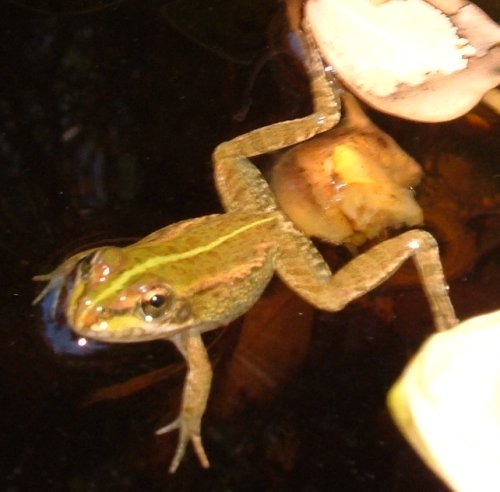The freshwater fauna of Tenerife
Animals that live in Tenerife's freshwater
Tenerife has very little standing freshwater that occurs naturally on the island, although a surprising range of aquatic creatures and plants can be found in the reservoirs, water tanks and ornamental garden ponds.
There are temporary streams and pools in the rainy season of autumn, winter and early spring and a few permanent sources of freshwater too. All these habitats provide homes for the freshwater fauna of Tenerife.
Freshwater animals from Tenerife







Two species of frog
It may come as a surprise to many to discover that there are two types of frog living and breeding on the island, and there are quite large numbers in the localities where they can be found.
The freshwater ponds in Erjos in the nort west of Tenerife provide a suitable environment for the two species that can be heard and seen in the pools in spring.
The Iberian Water frog (Rana perezii), or "Rana Comun" to give it its Spanish name, is a large frog that also lives on mainland Spain as well as in parts of North Africa where there are freshwater sources available.
It lives and breeds in the ornamental ponds in Parque García Sanabria in Santa Cruz, in pools at the Las Gangarras restaurant in Buzanada down in the hot south of the island, as well as in the ponds of Erjos.
This Iberian Water Frog spends most of its time in or close to the water and feeds on insects and spiders. It has large tadpoles that can be seen in the ponds where it lives.
The other species of frog found on Tenerife is the very much smaller Stripeless or Mediterranean Tree frog (Hyla meridionalis). In Spanish it is known as "Rana Verde" (Green Frog) or "Ranita" (Little frog). This type of frog lives on farms and banana plantations and often breeds in the irrigation tanks as well as in the reservoirs. The Mediterranean Tree frog calls after rain and at night and can often be heard quite loudly in areas where they live.
The most commonly encountered freshwater fish that lives on Tenerife is the Mosquito Fish (Gambusia affinis and Gambusia holbrooki). These little fish are live-bearers like the Guppy and give birth to tiny baby fry. They originally came from the Gulf of Mexico and the Southern States of the USA but they have been introduced all over the world in sub-tropical and tropical countries with the aim of combatting the insect pest it is named after.
Mosquito fish females are a lot bigger than the males and can reach just over two inches. An adult female can give birth to as many as 50 babies in one go.
Mosquito fish are very hardy and can survive in saltwater as well as in fresh water. They are able to live in brackish and polluted waters.
Countless thousands live in the irrigation tanks and reservoirs all around the island of Tenerife, and there is a very large population in the hot salty and dirty pools on the rubbish-strewn waste ground in front of the beach in Las Galletas.
Two more commonly kept livebearer tropical fish have been introduced to some ponds in Tenerife. They are the Guppy (Poecilia reticulata) and the Platy (Xiphophorus maculatus), both of which are popular with tropical fish keepers.
The European Eel (Anguilla anguilla) is said to live in a permanent streams and pool in the Afur hamlet in the remote Anaga Mountains in the extreme north of Tenerife. It breeds at sea and migrates inland as a baby eel or elver.
Freshwater carp of various species have been put in some large ponds and in reservoirs, and it is possible to go carp fishing on Tenerife.
Because they can fly about to find new habitats there are many aquatic insects in Tenerife. The most conspicuous is the large Emperor Dragonfly (Anax imperator) . The males are an electric blue, whilst the females are a greenish shade.
The Scarlet Darter (Crocothemis erythraea) has a bright red male, as its name suggests, and the female is a drab yellow.
The much slimmer and smaller Saharan Blue-tailed Damselfly (Ischnura elegans saharensis) lives in some areas of Tenerife, such as the pools in Las Galletas, already mentioned above. The larvae of both dragonflies and damselflies prey on smaller aquatic animals including tadpoles and fish that they manage to capture.
There is a Mayfly (Chloeon dipteron) that lives on Tenerife where it breeds in water tanks, ponds and reservoirs. This delicate insect only lives for a day or so as an adult and spends most of its life as an aquatic nymph.
There are several species of water beetles and water bugs that can be found in the freshwater habitats on the island.
The Whirligig beetle (Gyrinus dejeanii) is often seen in large groups whirling around on the surface of pools and water tanks, and the very big Great Diving Beetle (Cybister tripunctatus) also lives in ponds and standing water where it hunts for prey.
The Pond-skater (Gerris thoracicus) walks on water and moves across the surface-film as it seeks tiny insects like flies that have fallen in.
Water Boatmen, both the larger type (Notonecta canariensis) and the Lesser Water-boatman (Corixa affinis), both can be found Tenerife, and sometimes in very large numbers when conditions suit them.








